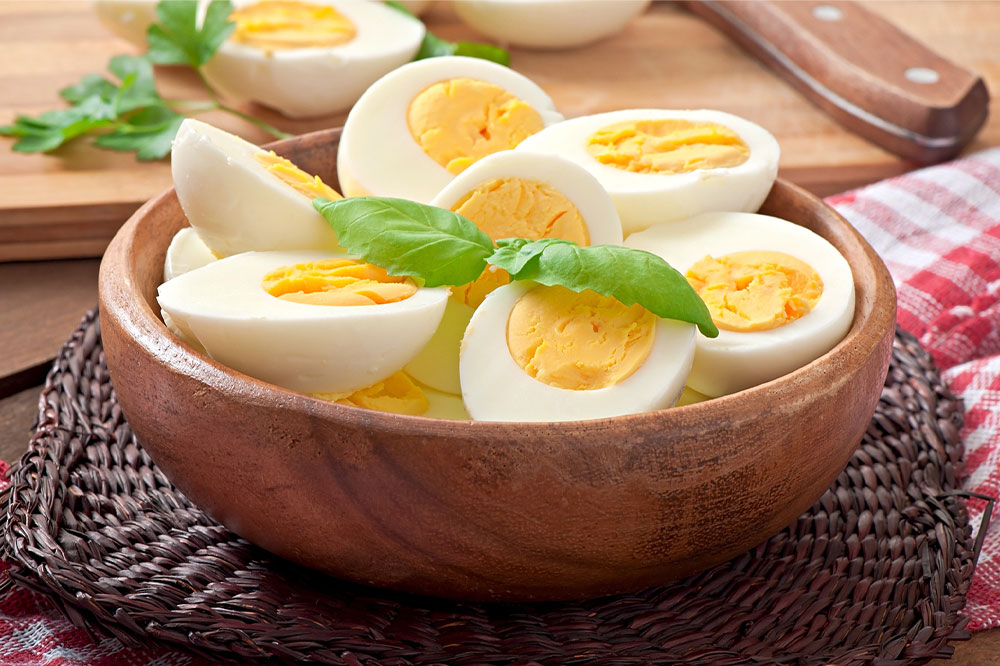12 best foods to eat for healthy hair

What you eat impacts your hair’s health. Hair loss affects a significant portion of the population, irrespective of age. The numbers increase as we go up the age ladder. Of course, this can be due to aging, underlying health conditions, and other things, along with a lack of nutrition. Nutritionally poor foods can cause loss of hair density, poor growth, and weaker hair strands. So, here is a list of foods to eat for healthy hair.
Eggs
Eggs are a superfood, and for good reason. They are rich in biotin, protein, vitamins A and E, calcium, and iron. They are also an incredible source of omega-3 fatty acids. These ingredients are excellent if you want to accelerate hair growth and strengthen it. The biotin content enhances their keratin production, leading to better hair health.
Spinach
Everyone knows how critical spinach and other green vegetables are for anyone who wants a healthy mind and body. Spinach is a rich source of iron and loaded with multiple vitamins, which can assist in growing a healthier mane. Iron improves the quantity and quality of Red Blood Cells (RBCs), aiding in better oxygen supply to every cell in the body. Vitamin C is known to increase the absorption and availability of iron in the body. All of these make spinach a must-have food for people who wish to improve their hair health.
Sweet potato
Sweet potatoes are a delicious and healthy way of ensuring your meals are packed with calcium, iron, vitamin A, and vitamin C. Thanks to their long list of healthy nutrients like beta-carotene, they are also considered a superfood. The body converts the available amount of beta-carotene into vitamin A. Since it is important for cell growth, including foods rich in vitamin A or compounds that lead to increased production of the vitamin is beneficial for healthy hair.
Blueberries
Blueberries are a powerhouse of nutrients. They are loaded with antioxidants and micronutrients that help improve the body’s health and strength. The high level of antioxidants protects the hair from free radical damage. They also enhance the body’s collagen production, making achieving the mane of your dreams easier. Other berries, like strawberries and raspberries, also provide similar benefits. Fruits like oranges, tangerines, grapefruits, and pomegranates can also improve hair health.
Salmon
You must have encountered numerous people raving about the benefits of adding fatty fish to your grocery list. They aren’t just great for your internal organs but also functionally improve your hair’s texture, strength, and density. Omega-3, vitamin D, and high protein content might help control excessive hair fall. Fish like salmon, mackerel, and tuna can be added to the meal plan twice a week or more.
Yogurt
Yogurt has been known for the host of benefits it can provide to the bones and the gut. But it can also be used to enhance hair health. Yogurt is rich in protein, calcium, iron, and other vitamins. And if you eat Greek yogurt, you will get more protein. It is also rich in zinc, which enhances the quality and density of hair. In addition, you will also find riboflavin in Greek yogurt, which is essential for cell growth.
Walnuts
Looking for an easy and handy snack to munch on? Grab a small handful of walnuts and stash them in your lunch bag. Or any other nuts or seeds, for that matter. Most nuts and seeds are packed with omega-3 fatty acids and other essential fats. They are also rich in essential minerals like iron, zinc, magnesium, potassium, and vitamins. Nuts and seeds are also good protein sources, making them easier to include. You can use almonds, walnuts, pistachios, flax seeds, hemp seeds, sunflower seeds, pumpkin seeds, and chia seeds.
Beans
Another thing to add to your meals is some beans. To replicate their benefits, you can also include other legumes besides beans and peanuts. Legumes are a great choice to add essential minerals and plant protein to your meals. Their biotin content can help in the healthy development of hair quality and quantity. Iron improves blood production and circulation, and the required zinc levels in the body are known to improve hair growth and density.
Oysters
There is no denying the importance of protein in accelerating hair growth and making it strong. And oysters are packed to the gills with protein and another essential nutrient for hair growth, which is zinc. Getting your hands on some oysters can be a little difficult, but if you do, know that you can access a great amount of zinc for your hair. If you include an appropriate amount of oysters in your day, you stand a better chance of having stronger and healthier hair.
Avocados
Avocados have long been touted as healthy foods that pair perfectly with toast, smoothies, eggs, salads, rice, and wraps. They are a rich source of good fats that help the body perform its functions optimally and without any kinks. Avocados also have a healthy dose of vitamin E, which can prevent free radical damage to cells. Although there is a need for more concrete evidence, it is believed that vitamin E can increase hair growth and that healthy fats can improve hair quality.
Milk
Milk is a rich source of calcium, vitamin D, protein, and other essential minerals. It is widely known for its health benefits. For some, milk is also a staple, making its inclusion easier for regular intake. However, if you have acne, you would want to speak to a doctor before regular milk intake, as it can exacerbate your acne issues.
Red bell peppers
We have already established that vitamin C is a key component of healthy hair. Since the body cannot produce vitamin C, it is important to supplement with food. In addition to this essential antioxidant, red bell peppers are also rich in vitamin A. You can add bell peppers to salads, stir-fries, or sauces to reap their nutritional benefits.





